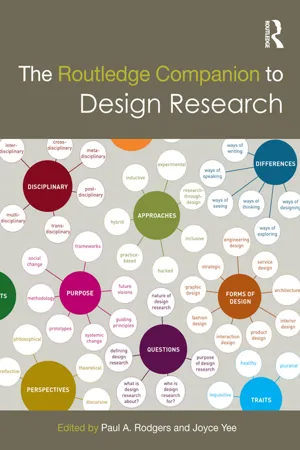
The Routledge Companion to Design Research
- 522 pages
- English
- ePUB (mobile friendly)
- Available on iOS & Android
The Routledge Companion to Design Research
About this book
The Routledge Companion to Design Research offers a comprehensive examination of design research, celebrating the plurality of design research and the wide range of conceptual, methodological, technological and theoretical approaches evident in contemporary design research.
This volume comprises 39 original and high quality design research chapters from contributors around the world, with offerings from the vast array of disciplines in and around modern design praxis, including areas such as industrial and product design, visual communication, interaction design, fashion design, service design, engineering and architecture.
The Companion is divided into five distinct sections with chapters that examine the nature and process of design research, the purpose of design research, and how one might embark on design research. They also explore how leading design researchers conduct their design research through formulating and asking questions in novel ways, and the creative methods and tools they use to collect and analyse data. The Companion also includes a number of case studies that illustrate how one might best communicate and disseminate design research through contributions that offer techniques for writing and publicising research.
The Routledge Companion to Design Research will have wide appeal to researchers and educators in design and design-related disciplines such as engineering, business, marketing, computing, and will make an invaluable contribution to state-of-the-art design research at postgraduate, doctoral, and post-doctoral levels and teaching across a wide range of different disciplines.
Frequently asked questions
- Essential is ideal for learners and professionals who enjoy exploring a wide range of subjects. Access the Essential Library with 800,000+ trusted titles and best-sellers across business, personal growth, and the humanities. Includes unlimited reading time and Standard Read Aloud voice.
- Complete: Perfect for advanced learners and researchers needing full, unrestricted access. Unlock 1.4M+ books across hundreds of subjects, including academic and specialized titles. The Complete Plan also includes advanced features like Premium Read Aloud and Research Assistant.
Please note we cannot support devices running on iOS 13 and Android 7 or earlier. Learn more about using the app.
Information
Part IWhat is design research?
1 The Sometimes Uncomfortable Marriages of Design and Research
Personal introduction
Design
- disignare, meaning to draw (hence the identification of designing with drawing)
- designare, meaning to designate
- arkhi-, meaning chief
- tekto¯n, meaning builder
Table of contents
- Cover Page
- Half-Title Page
- Title Page
- Copyright Page
- Table of Contents
- Notes on contributors
- Introduction
- PART I What is design research? The nature and process of design research; the purpose of design research; research approaches
- PART II How do we embark on design research? Formulating research questions; conducting a literature search and review; developing a research plan
- PART III How do we conduct design research? Asking questions; data collection methods; analysing information; ethical issues
- PART IV How do we communicate design research? Writing techniques; writing for your audience; publicising your research
- PART V Examples of design research? How we embark on design research; how we conduct design research; how we communicate design research
- Celebrating the plurality of design research
- Index